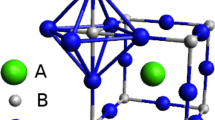Abstract
Lead-halide organic–inorganic perovskite material has recently been the focus of investigation by numerous research groups due to its favorable properties when employed as an active layer in a wide range of photovoltaic and optoelectronic devices. 2D perovskite layered type was introduced as a solution to the inherent moisture instability of the 3D counterpart, while at the same time enabling the tunability of the aforementioned properties through a spacer to perovskite layer ratio. However, theoretical studies of the layered 2D perovskites have been limited to the density functional level of theory (DFT) due to the lack of reliable force-fields that are necessary to explore the properties of this material observable only on a large scale. In this work, we employed the machine learning enabled Spectral Neighbor Analysis Potential (SNAP) to obtain the quantum accurate description of energies and forces in 2D layered Ruddlesden–Popper perovskite material, with butylammonium (BA) molecule included as a spacer. The trained SNAP potential reproduces both energies and forces of the reference atomic configurations with high fidelity and comparable with DFT calculations. Furthermore, the potential is stable at both 300 and 400 K which is verified for the first five 2D perovskite members under the canonical ensemble in bulk phase for 0.5 ns.










Similar content being viewed by others
Data availability
The SNAP potential file, and respective LAMMPS input scripts and data files are available from the repository https://github.com/CNNLSinica/2D_perov_SNAP.
References
S. De Wolf et al., Organometallic Halide Perovskites: sharp optical absorption edge and its relation to photovoltaic performance. J. Phys. Chem. Lett. 5, 1035–1039 (2014)
Q. Dong et al., Electron-hole diffusion lengths > 175 μm in solution-grown CH3NH3PbI3 single crystals. Science 1979(347), 967–970 (2015)
C. Wehrenfennig, G.E. Eperon, M.B. Johnston, H.J. Snaith, L.M. Herz, High charge carrier mobilities and lifetimes in organolead trihalide perovskites. Adv. Mater. 26, 1584–1589 (2014)
D.W. de Quilettes et al., Impact of microstructure on local carrier lifetime in perovskite solar cells. Science (1979) 348, 683–686 (2015)
W.-J. Yin, T. Shi, Y. Yan, Unique properties of halide perovskites as possible origins of the superior solar cell performance. Adv. Mater. 26, 4653–4658 (2014)
J.H. Noh, S.H. Im, J.H. Heo, T.N. Mandal, S.I. Seok, Chemical management for colorful, efficient, and stable inorganic-organic hybrid nanostructured solar cells. Nano Lett. 13, 1764–1769 (2013)
G. Pacchioni, Highly efficient perovskite LEDs. Nat. Rev. Mater. 6, 108 (2021)
L. Li et al., Recent advances in perovskite photodetectors for image sensing. Small 17, 2005606 (2021)
J.Y. Kim, J.-W. Lee, H.S. Jung, H. Shin, N.-G. Park, High-efficiency perovskite solar cells. Chem. Rev. 120, 7867–7918 (2020)
T. Wu et al., The main progress of perovskite solar cells in 2020–2021. Nanomicro Lett 13, 152 (2021)
A. Kojima, K. Teshima, Y. Shirai, T. Miyasaka, Organometal halide perovskites as visible-light sensitizers for photovoltaic cells. J. Am. Chem. Soc. 131, 6050–6051 (2009)
H. Min et al., Perovskite solar cells with atomically coherent interlayers on SnO2 electrodes. Nature 598, 444–450 (2021)
J. Yan, T.J. Savenije, L. Mazzarella, O. Isabella, Progress and challenges on scaling up of perovskite solar cell technology. Sustain Energy Fuels 6, 243–266 (2022)
J.M. Frost et al., Atomistic origins of high-performance in hybrid halide perovskite solar cells. Nano Lett. 14, 2584–2590 (2014)
E. Mosconi, J.M. Azpiroz, F. De Angelis, Ab initio molecular dynamics simulations of methylammonium lead iodide perovskite degradation by water. Chem. Mater. 27, 4885–4892 (2015)
C. Zheng, O. Rubel, Unraveling the water degradation mechanism of CH3NH3PbI3. J. Phys. Chem. C 123, 19385–19394 (2019)
Z.-Q. Ma, Y. Shao, P.K. Wong, X. Shi, H. Pan, Structural and electronic properties of two-dimensional organic–inorganic halide perovskites and their stability against moisture. J. Phys. Chem. C 122, 5844–5853 (2018)
C. Katan, N. Mercier, J. Even, Quantum and dielectric confinement effects in lower-dimensional hybrid perovskite semiconductors. Chem. Rev. 119, 3140–3192 (2019)
C.C. Stoumpos et al., Ruddlesden-popper hybrid lead iodide perovskite 2D homologous semiconductors. Chem. Mater. 28, 2852–2867 (2016)
D.B. Mitzi, Templating and structural engineering in organic–inorganic perovskites. J. Chem. Soc. Dalton Trans. (2001). https://doi.org/10.1039/B007070J
K. Tanaka et al., Comparative study on the excitons in lead-halide-based perovskite-type crystals CH3NH3PbBr3CH3NH3PbI3. Solid State Commun. 127, 619–623 (2003)
X. Hong, T. Ishihara, A.V. Nurmikko, Dielectric confinement effect on excitons in PbI4-based layered semiconductors. Phys. Rev. B 45, 6961–6964 (1992)
E.A. Muljarov, S.G. Tikhodeev, N.A. Gippius, T. Ishihara, Excitons in self-organized semiconductor/insulator superlattices: PbI-based perovskite compounds. Phys. Rev. B 51, 14370–14378 (1995)
I.B. Koutselas, L. Ducasse, G.C. Papavassiliou, Electronic properties of three- and low-dimensional semiconducting materials with Pb halide and Sn halide units. J. Phys.: Condens. Matter 8, 1217–1227 (1996)
J.-C. Blancon et al., Scaling law for excitons in 2D perovskite quantum wells. Nat. Commun. 9, 2254 (2018)
C.M. Raghavan et al., Low-threshold lasing from 2D homologous organic-inorganic hybrid Ruddlesden-popper perovskite single crystals. Nano Lett. 18, 3221–3228 (2018)
P.K. Roy et al., Unprecedented random lasing in 2D organolead halide single-crystalline perovskite microrods. Nanoscale 12, 18269–18277 (2020)
Z. Tan et al., Two-dimensional (C4H9NH3)2PbBr4 perovskite crystals for high-performance photodetector. J. Am. Chem. Soc. 138, 16612–16615 (2016)
F. Yuan et al., Color-pure red light-emitting diodes based on two-dimensional lead-free perovskites. Sci. Adv. 6, eabb0253 (2022)
I.C. Smith, E.T. Hoke, D. Solis-Ibarra, M.D. McGehee, H.I. Karunadasa, A layered hybrid perovskite solar-cell absorber with enhanced moisture stability. Angew. Chem. 126, 11414–11417 (2014)
H. Tsai et al., High-efficiency two-dimensional Ruddlesden-popper perovskite solar cells. Nature 536, 312–317 (2016)
G. Wu et al., Molecular engineering for two-dimensional perovskites with photovoltaic efficiency exceeding 18%. Matter 4, 582–599 (2021)
S. Sidhik et al., Deterministic fabrication of 3D/2D perovskite bilayer stacks for durable and efficient solar cells. Science 1979(377), 1425–1430 (2022)
A. Mattoni, A. Filippetti, M.I. Saba, P. Delugas, Methylammonium rotational dynamics in lead halide perovskite by classical molecular dynamics: the role of temperature. J. Phys. Chem. C 119, 17421–17428 (2015)
T. Hata, G. Giorgi, K. Yamashita, C. Caddeo, A. Mattoni, Development of a classical interatomic potential for MAPbBr3. J. Phys. Chem. C 121, 3724–3733 (2017)
S.S.I. Almishal, O. Rashwan, New accurate molecular dynamics potential function to model the phase transformation of cesium lead triiodide perovskite (CsPbI3). RSC Adv. 10, 44503–44511 (2020)
C.M. Handley, C.L. Freeman, A new potential for methylammonium lead iodide. Phys. Chem. Chem. Phys. 19, 2313–2321 (2017)
M.B. Fridriksson, S. Maheshwari, F.C. Grozema, Structural dynamics of two-dimensional Ruddlesden-popper perovskites: a computational study. J. Phys. Chem. C 124, 22096–22104 (2020)
H.-A. Chen, C.-W. Pao, Fast and accurate artificial neural network potential model for MAPbI3 perovskite materials. ACS Omega 4, 10950–10959 (2019)
A.P. Thompson, L.P. Swiler, C.R. Trott, S.M. Foiles, G.J. Tucker, Spectral neighbor analysis method for automated generation of quantum-accurate interatomic potentials. J. Comput. Phys. 285, 316–330 (2015)
M.A. Wood, A.P. Thompson, Extending the accuracy of the SNAP interatomic potential form. J. Chem. Phys. 148, 241721 (2018)
D.H. Cao, C.C. Stoumpos, O.K. Farha, J.T. Hupp, M.G. Kanatzidis, 2D homologous perovskites as light-absorbing materials for solar cell applications. J. Am. Chem. Soc. 137, 7843–7850 (2015)
C.C. Stoumpos et al., High members of the 2D Ruddlesden-Popper halide perovskites: synthesis, optical properties, and solar cells of (CH3(CH2)3NH3)2(CH3NH3)4Pb5I16. Chem 2, 427–440 (2017)
C.M. Myae Soe et al., Structural and thermodynamic limits of layer thickness in 2D halide perovskites. Proc Natl Acad Sci U S A 116, 58–66 (2019)
A.P. Bartók, R. Kondor, G. Csányi, On representing chemical environments. Phys. Rev. B 87, 184115 (2013)
A.P. Bartók, M.C. Payne, R. Kondor, G. Csányi, Gaussian approximation potentials: the accuracy of quantum mechanics, without the electrons. Phys. Rev. Lett. 104, 136403 (2010)
D.A. Varshalovich, A.N. Moskalev, V.K. Khersonskii, Quantum Theory of Angular Momentum (World Scientific, Singapore, 1988)
A.V. Meremianin, Multipole expansions in four-dimensional hyperspherical harmonics. J. Phys. A 39, 3099–3112 (2006)
D.B. Mitzi, Synthesis, crystal structure, and optical and thermal properties of (C4H9NH3)2MI4 (M = Ge, Sn, Pb). Chem. Mater. 8, 791–800 (1996)
C.C. Stoumpos et al., SI_Ruddlesden-Popper hybrid lead iodide perovskite homologous semiconductors. Chem. Mater. 28(8), 2852–2867 (2016)
G. Kresse, J. Furthmüller, Efficient iterative schemes for ab initio total-energy calculations using a plane-wave basis set. Phys. Rev. B 54, 11169–11186 (1996)
H.J. Monkhorst, J.D. Pack, Special points for Brillouin-zone integrations. Phys. Rev. B 13, 5188–5192 (1976)
J.P. Perdew, K. Burke, M. Ernzerhof, Generalized gradient approximation made simple. Phys. Rev. Lett. 77, 3865–3868 (1996)
P.E. Blöchl, Projector augmented-wave method. Phys. Rev. B 50, 17953–17979 (1994)
G. Kresse, D. Joubert, From ultrasoft pseudopotentials to the projector augmented-wave method. Phys. Rev. B 59, 1758–1775 (1999)
S. Grimme, J. Antony, S. Ehrlich, H. Krieg, A consistent and accurate ab initio parametrization of density functional dispersion correction (DFT-D) for the 94 elements H-Pu. J. Chem. Phys. 132, 154104 (2010)
S. Grimme, S. Ehrlich, L. Goerigk, Effect of the damping function in dispersion corrected density functional theory. J. Comput. Chem. 32, 1456–1465 (2011)
A.P. Thompson et al., LAMMPS - a flexible simulation tool for particle-based materials modeling at the atomic, meso, and continuum scales. Comput. Phys. Commun. 271, 108171 (2022)
L.P. Swiler, M.S. Eldred, B.M. Adams, Dakota: bridging advanced scalable uncertainty quantification algorithms with production deployment, in Handbook of Uncertainty Quantification. ed. by R. Ghanem, D. Higdon, H. Owhadi (Springer International Publishing, Cham, 2017), pp.1651–1693
Acknowledgements
We would like to thank Academia Sinica Investigator Award (Grant No. AS-IA-112-M05), and the National Science and Technology Council, Taiwan (Grant Nos. 108-2112-M-001-024-MY3, 111-2112-M-001-085-MY3, and 111-2124-M-001-001-) for funding support. We would also like to thank the National Center for High-Performance Computing, Taiwan for computational support.
Author information
Authors and Affiliations
Corresponding author
Ethics declarations
Conflict of interest
The authors declare no conflicts of interests.
Additional information
Publisher's Note
Springer Nature remains neutral with regard to jurisdictional claims in published maps and institutional affiliations.
Supplementary Information
Below is the link to the electronic supplementary material.
Supplementary file1 (MP4 20713 KB)
Supplementary file2 (MP4 20776 KB)
Supplementary file3 (MP4 20434 KB)
Supplementary file4 (MP4 20400 KB)
Supplementary file5 (MP4 20480 KB)
Supplementary file6 (MP4 20507 KB)
Supplementary file7 (MP4 20519 KB)
Supplementary file8 (MP4 20553 KB)
Supplementary file9 (MP4 20440 KB)
Supplementary file10 (MP4 20569 KB)
Rights and permissions
Springer Nature or its licensor (e.g. a society or other partner) holds exclusive rights to this article under a publishing agreement with the author(s) or other rightsholder(s); author self-archiving of the accepted manuscript version of this article is solely governed by the terms of such publishing agreement and applicable law.
About this article
Cite this article
Najman, S., Yang, PY. & Pao, CW. Machine Learning Enabled Potential for (BA)2(MA)(n−1)PbnI3n+1 2D Ruddlesden–Popper Perovskite Materials. Multiscale Sci. Eng. (2024). https://doi.org/10.1007/s42493-024-00108-8
Received:
Revised:
Accepted:
Published:
DOI: https://doi.org/10.1007/s42493-024-00108-8




